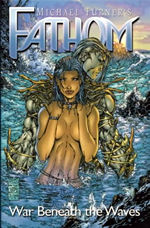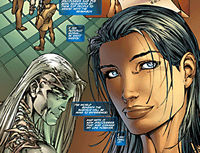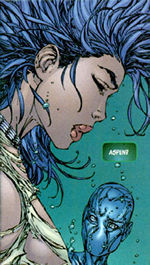>> The Friday Review: The Birthday Riots
>> The Friday Review: A Distant Soil: The Gathering
More...

 Writers: Michael Turner, Bill O'Neill
Writers: Michael Turner, Bill O'Neill
Artist: Michael Turner
Collecting FATHOM #1-9
Price: £10.99
Publisher: Titan Books
ISBN: 1-84023-230-7
When FATHOM first launched, both the book and its artist and co-creator, Michael Turner, had a certain reputation. Among the last of the Image "rock star" artists, Turner's work was regarded as little more than cheesecake. WITCHBLADE was selling impressively, but to many it was an artistically vapid book with little or no appeal.
To make matters worse, FATHOM was one of two books to launch with the mercifully short-lived gimmick of "variant internal pages". Three separate issue 1s were printed, each containing several pages from different points of view. While this made for an interesting narrative approach and, more importantly, fleshed out Top Cow's coffers, it did nothing to endear the series to potential readers.
However, a couple of years on from this, the time seems right to re-appraise both artist and series. WAR BENEATH THE WAVES, Titan Books' UK collection of the opening nine-part story arc, provides the perfect means for doing this.
The series opens in flashback, with a cruise liner coming into port, everything appearing normal. However, this cruise liner has been missing for a decade and has gained a passenger, a young girl with no memory of how she got there. She's adopted by the captain of the liner and christened Aspen.
From there, the series moves onto the present day, where Aspen has become a marine biologist, offered a job at Deep Marine Discovery (DMD), a top-secret US/Japanese research facility. There, she finds herself caught up with Chance "Joker" Calloway, a US Navy pilot flying a highly classified submersible fighter plane. The meeting between the two propels them both into a conflict that's been going on for centuries, and a threat to all civilised life on the planet.
Needless to say, this isn't exactly subtle stuff. When summarised, for example, the main characters all fit squarely into action-movie stereotypes:
Aspen: The brilliant young woman with the troubled past.
Joker: The smart-mouth fighter pilot forced to accept responsibility for his actions.
Cannon Hawke: The handsome, mysterious stranger who knows far more than he's saying.
Admiral Maylander: The senior officer who knows what's going on and agonises over his choices.
Killian: Tortured (and photogenic) villain.
 This familiarity is both a strength and a weakness of the series, providing an instant hook for readers to latch onto, but presenting the constant danger of making the series seem cliché and safe. These are all characters that we, as 21st century readers, have come across hundreds of times before. The challenge for WAR BENEATH THE WAVES is to take these old characters in a new direction, ensuring that while they're far from original, they at least remain interesting.
This familiarity is both a strength and a weakness of the series, providing an instant hook for readers to latch onto, but presenting the constant danger of making the series seem cliché and safe. These are all characters that we, as 21st century readers, have come across hundreds of times before. The challenge for WAR BENEATH THE WAVES is to take these old characters in a new direction, ensuring that while they're far from original, they at least remain interesting.
This challenge is met by both the nature and scale of the story. WAR BENEATH THE WAVES is equal parts Jerry Bruckheimer-style spectacle and sweaty palmed conspiracy theory. Over the course of the book, armed conflict breaks out between two nations, a second war is fought in the shadow of the first, and undersea fighter planes clash with coral-shaped UFOs, taking in Easter Island, low Earth orbit and the end of civilisation along the way.
Were this any other Top Cow book of the era, there would be more than enough information in these first nine issues to power a good two years of stories. However, FATHOM races through its first story at breakneck pace, establishing its world and then standing that world on its head.
Equally impressive is the fact that, unlike so many other series, actions actually have consequences in FATHOM. The issues published after the conclusion of WAR BENEATH THE WAVES dealt with its aftermath in a surprising and original manner, placing the events of this opening story in context for the rest of the series.
Each issue is partially narrated from the point of view of one character, with that character presented in half profile on the page. It's a simple technique but one that goes a long way toward giving the series a unique style. It also helps emphasise the epic scale of this opening story, with characters in geographically disparate locations making decisions that affect every other character in the series. Overall, the effect is similar to the characterisation of the Deepcore crew in THE ABYSS, or the fire team in ALIENS. These people are established as individuals, with individual agendas, and those agendas align or conflict as the story goes.
 From an artistic point of view, it's immediately obvious that this is a labour of love for Turner. A keen scuba diver, he brings a genuine sense of depth and, more importantly, of the "alien" to the series' numerous underwater sequences.
From an artistic point of view, it's immediately obvious that this is a labour of love for Turner. A keen scuba diver, he brings a genuine sense of depth and, more importantly, of the "alien" to the series' numerous underwater sequences.
There's a genuine sensation of scale in these sequences, in particular the land to underwater chase sequence in the fourth chapter. The chase begins on land, goes to the beach, the surface of the ocean and finally the ocean itself, with the characters employing various vehicles and their own special abilities.
It is a beautifully constructed sequence that flows effortlessly from beginning to end. More importantly, it serves to demonstrate Turner's obsession with making the series as authentic as possible. The seabed, instead of being barren sand dunes, is a labyrinthine forest of seaweed through which the characters battle. It's even the right type for the area of ocean the series is set in.
However, the real stars of the show, from an artistic point of view at least, are the undersea civilisations that lie at the heart of the story. Again, there's a palpably alien feel to them, neatly communicated by scaling the inhabitants up very slightly from the humans. These beings are only glimpsed in the opening episodes of the series, and their motives remain in question for much of the book.
Artistically, this race lies at the centre of the series. Using water and coral as the basis for everything from their weapons to their buildings, Turner and Bill O'Neill appear to have taken great pains to give the undersea race a history, technology and a coherent design philosophy.
Where Turner's art has traditionally fallen down is in some aspects of his character work, and to some extent that's true of FATHOM as well. Aspen, the main character, is very much a standard Top Cow woman as the series opens, complete with nine-foot legs and a waist narrower than most people's hands. Similarly, the near-Aryan perfection of the undersea race at times appears to be little more than an excuse to show off acres of toned flesh. This is particularly true in WAR BENEATH THE WAVES, where it sometimes seems only the male characters are allowed to be fully clothed at all times. While this tendency dies out almost completely in later issues, it remains WAR BENEATH THE WAVES' weakest point.
The greatest strength of WAR BENEATH THE WAVES is that it is both unabashedly daft and boundlessly enthusiastic. Turner and O'Neill have an immense, world-shattering story to tell, and are having such a fantastic time doing it that it's hard not to get caught up in their love for the work. There are problems here - the Top Cow obsession with flesh being at the top of the list - but there's also much to enjoy. It's unusually designed, interesting escapist fun. Just like any good summer blockbuster.

This article is Ideological Freeware. The author grants permission for its reproduction and redistribution by private individuals on condition that the author and source of the article are clearly shown, no charge is made, and the whole article is reproduced intact, including this notice.


